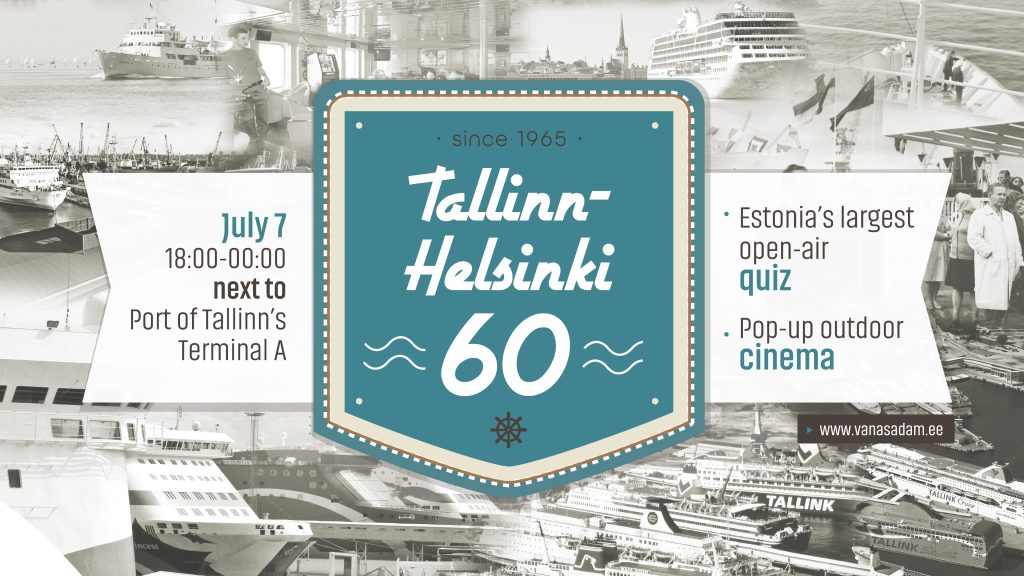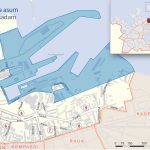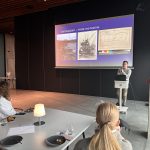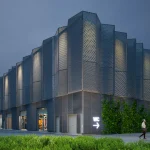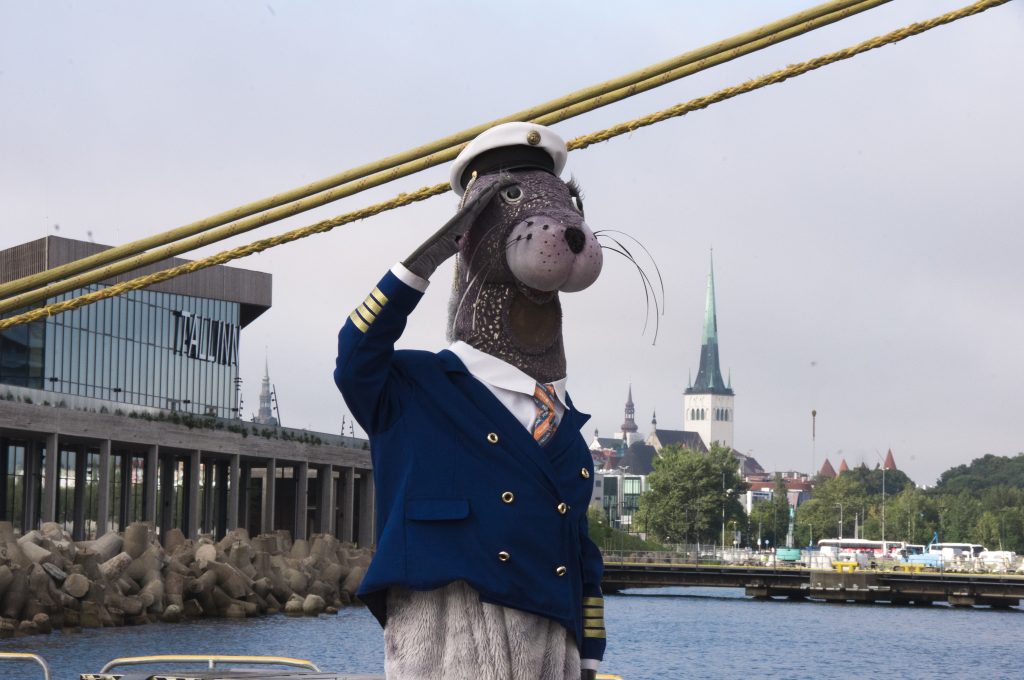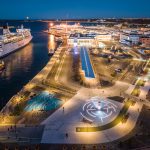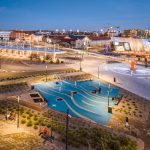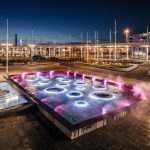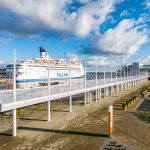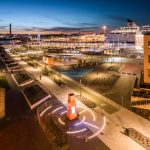Port of Tallinn invites you to the Old City Harbour to celebrate the 60th anniversary of the Tallinn-Helsinki ferry route on July 7 at 6:00 PM.
To honor the long-standing friendship between Estonia and Finland, the evening will feature Estonia’s largest outdoor quiz. Everyone is welcome to take part in the quiz. The questions will come from both sides of the Gulf.
The evening will conclude with a joint screening of an Finnish movie „100 Litres of Gold“ ( 100 litraaa sahtia) at a pop-up open-air cinema.
WHEN?
Monday, July 7 from 6PM to 12AM
WHERE?
Next to Terminal A, at Tallinn Old City Harbour
WHAT’S HAPPENING?
- 6PM – To honor the long-standing friendship between Estonia and Finland, the evening will feature Estonia’s largest outdoor quiz. Everyone is welcome to take part in the quiz. The questions will come from both sides of the Gulf.
- Fun travel stories, food and drink
- 9 PM – Musical stand-up Sten Erik Allikas
- 10PM – The evening will conclude with a joint screening of an Finnish movie „100 Litres of Gold“ (100 litraaa sahtia) at a pop-up open-air cinema.
ADDITIONAL INFO:
The quiz questions have been prepared by the Spordipilet.ee team, and the cinema experience is brought to you by Elektriteater. Prizes are provided by Tallink, Ecekrö Line, Viking Line and Prisma Peremarketid.
The event takes place at the Port of Tallinn’s Old City Harbour next to Terminal A. In case of bad weather, it will be held inside Terminal A.
Let’s celebrate the Estonian-Finnish friendship! See you at the port!
Port of Tallinn is a versatile company that, in addition to its traditional port operations, is actively engaged in real estate development in the heart of Tallinn at the Old City Harbor. Our land plots offer multiple long-term usage opportunities.
As a passenger port in the heart of Tallinn we hold very important the relationship with the community surrounding us. Even more so because we own land next to our port area, which is under planning process now. Our goal is to create an attractive, vibrant waterfront cityscape, featuring residential spaces, offices, and business premises, complemented by culture and leisure opportunities.
To foster collaboration and open discussions, we recently hosted the first community and business meeting for the Harbor district, bringing together over 20 local companies, residents, and key stakeholders. With the Harbour district’s population growing steadily careful planning is essential to ensure that future developments meet community expectations, and the area will be full of life and local people will have more reasons to come to harbour area besides going to the ferry. Port of Tallinn has approx. 300 000 m2 of buildable area under planning. Together with other landowners the potential development volume in Harbour´s district will be approx. 950 000 m2.
This demonstrates that the area’s development matters equally to all of us. The next meeting will take place on May 13 at the Estonian Museum of Architecture during the event „(H)arutus“ on the topic “Does the shoreline belong to the community?”
We see Old City Harbor as a key area for future development, and we’re eager to work with real estate partners, businesses, and the community to create a well-connected, functional, and modern city space.
More information about Port of Tallinn´s Old City Harbour development, visit www.oldcityharbour.com or contact our Real Estate Business Manager, Piret Üts.
PHOTOS>>
AS Tallinna Sadam and KOKO architects have successfully submitted and been granted Estonia’s first BIM-based building permit!
The project will be Old City Harbour’s largest substation, located in the Port of Tallinn area, in close proximity to the Cruise Terminal.
Eesti Kliimaministeerium is leading the BIM-based permitting process: since the beginning of 2024, it has been possible to submit a BIM model alongside a building permit application and use an application to verify whether the project meets the requirements. The BIM-based permitting process helps shorten the building permit approval timeline by automating the technical review of construction projects. A more efficient permitting process contributes to increasing productivity in the construction sector, which aligns with the broader development goals of the Ministry of Economic Affairs and Communications.
The Vanasadam (Old City Harbour) tramway was officially opened today, with regular tram services set to begin on Sunday, December 1.
The tramline was constructed by Merko Ehitus Eesti and KMG Infra. The project, which began in the spring of 2023 and concluded in the fall of 2024, involved the construction of approximately 2.5 kilometers of double-track tramline, complete with stops and a substation. Significant upgrades were also made to underground utilities and the surrounding streetscape.
The new tramline branches off from the Tartu maantee tramline, with a switch installed onto Gonsiori Street. The route then proceeds via A. Laikmaa, Hobujaama, and Ahtri Streets to the harbour area, continuing through the Cultural Hub and Linnahall to connect with the tramline leading to Kopli.
Starting December 1, tramline 2 will operate on the new tracks, running initially on the route Kopli–Vanasadam–Suur-Paala. Once construction of the Rail Baltica Ülemiste terminal progresses to allow trams to pass through the area, the line will be extended to the airport as soon as possible.
The new timetable for line 2 can be found on the website transport.tallinn.ee and will also be displayed at tram stops along the route starting Sunday. More details about the tramline and recent changes can be found at www.tallinn.ee/en/vanasadamatramm.
This is how the new Passenger Terminal A and the surrounding cityscape in Tallinn’s Old City Harbor will be looking like in the future.
Port of Tallinn’s Terminal A is one of Estonia’s biggest tourism gateways servicing 3-4 million passengers annually. Terminal services Viking Line and Eckerö Line ferries.
The detailed plan of the Terminal A area has been submitted to the Tallinn City Government for acceptance, and in parallel, a sketch of the A-terminal quarter with the surrounding public urban space has been completed.
The winning entry of the architectural competition for the A-terminal quarter is a conceptual design called Vihur, submitted by the architects of Molumba OÜ.

The cruise terminal of the Old City Harbour of Tallinn was awarded the Green Key, which assures both cruise passengers and the guests and partners visiting events at the cruise terminal that we operate in an environmentally sustainable manner. The flag of the Green Key certificate was hoisted at the cruise terminal by Minister of Climate Kristen Michal and Chairman of the Board of the Port of Tallinn Valdo Kalm.
Minister of Climate Kristen Michal congratulated the Port of Tallinn on receiving the Green Key certificate and stressed that a smaller environmental footprint is a competitive edge. “For a cruise terminal, this is reflected in added value for customers – the port generates less garbage, the buildings are heated and cooled by marine energy and local food producers are preferred.”
Chairman of the Board of the Port of Tallinn Valdo Kalm said that applying for the Green Key certificate for the cruise terminal of the Old City Harbour is part of the sustainable development strategy of the Port of Tallinn, one significant aim of which is to contribute to more rigorous environmentally friendly practices, decrease the ecological footprint of our activities, and meet the goals of sustainable development. “The Green Key is essentially a sign of quality in operating as an environmentally friendly and sustainable conference centre for the cruise terminal. Whereas for guests and event organisers, Green Key is a point in favour of choosing an event site and creates added value. We also encourage the partners, tenants and guests of the cruise terminal to organise their events according to the criteria of Green Key or in compliance with the overall principles of the Green Key programme,” Valdo Kalm added.
Green Key is an international ecological certificate for tourist undertakings and is a leading standard since 1994 used to acknowledge environmentally friendly and sustainable tourist destinations. Nearly 4000 companies from 60 countries worldwide have now obtained the certificate. The Green Key programme contributes to achieving the Sustainable Development Goals of the UN.
The cruise terminal of the Old City Harbour as a holder of the Green Key certificate complies with the following significant criteria:
- Requirements to waste: we sort garbage and recycle whenever possible. We avoid any excess packaging and the use of disposable dishes.
- Requirements to energy: we use automation in our facilities, energy is produced by solar panels adapted to the Nordic climate, the building is heated and cooled by marine energy via a heat pump.
- Requirements to water: we select taps and other sanitary equipment based on how much they save water and encourage our guests to drink tapwater.
- Requirements to food: we serve more vegetarian food, using domestically grown clean produce and produce from small manufacturers.
- Requirements to cleaning: cleaning agents are dosed in advance and we only use agents with an ecological certificate.
- Outdoor maintenance: we do not use pesticides and water sparingly, as needed.
- Purchases: we have chosen partners and suppliers whose transparency, integrity and responsibility we can be sure of.
The international promoter of Green Key is the Foundation for Environmental Education (FEE). Green Key offers an operating model to tourist undertakings to develop corporate environmental friendliness and a sustainable approach. A high level of environmental friendliness is ensured by documenting operations, independent auditing, and site inspections. In Estonia, the certificate is coordinated by the joint efforts of EAS and Kredex.
The modern and varied cruise terminal of the Old City Harbour and its promenade open up the seaside for the residents to spend their free time. The cruise terminal is a popular venue which stands out with its gorgeous and modern interior architecture. The modern and environmentally friendly cruise terminal and its surroundings can be used to host various events – conferences, exhibitions, fairs, concerts, corporate parties.
Read more about the Green key here and about the cruise terminal as a venue here.
Estonia’s most prominent port authority, Port of Tallinn, took another step closer to connecting the city centre of Tallinn with the seafront through the redevelopment of the square in front of Terminal D. The court will create an additional place for locals and Tallinn’s visitors to enjoy the seaside as well as providing a convenient connection to the city centre for ship passengers.
According to Valdo Kalm, Chairman of the Board of the Port of Tallinn, there is still a lot of work to be done in developing the Old City Harbour area. “However, the development projects show that it is possible to combine the port’s ship servicing functions with a modern urban space that considers the needs of pedestrians and cyclists.
“Terminal D’s former fully car-centric space filled with asphalt and concrete paving is now a thing of the past. Instead, we are looking forward to welcoming locals and tourists to spend time by the sea with their families, as well as event organisers who can use the area to offer enjoyable experiences for everyone,” added Kalm.
According to Mihhail Kõlvart, Mayor of Tallinn, the square in front of the D-Terminal will serve as a gateway to Tallinn and Estonia. “The port is an important connection between countries, and just as important as the connections from the port is the connection to the port. The new square in front of the D-Terminal will open up the city and the seafront to both travelers and the people of Tallinn,” said Kõlvart.
“Tallink is delighted that the front of D-Terminal, the home terminal for our ships, is now ready and will welcome seafarers arriving in Tallinn with a new look and the latest customer-friendly solutions. Together with the D-Terminal´s new building, it forms a harmonious whole as well as a representative business card for our guests at the capital’s most important sea gateway,” said Paavo Nõgene, Chairman of the Board of the Tallink Group.
The former 4500 m2 parking area now has more than 100 trees and 3,500 bushes to create a cosy atmosphere with a wide variety of seating. Awnings have been built to protect the passengers waiting for the bus and taxi from the rain, and a large area of landscaped green space has been created. In addition, two fascinating water features have been built to mark the location of the historic doughnut shop and the Girard Canal. Near the Admiral’s Bridge is a maritime-themed leisure area for children.
To ensure fast and smooth access to and from the ship, a bus park, taxi parking and Kiss & Sail parking for vehicles have been provided. New bus shelters have been created for public transport users on both sides of the street. Future tram users will be able to cross in front of the A-terminal of the Admiral’s Bridge, where a new tram stop will be completed in early 2025.
The project for the outdoor area in front of Terminal D of the Old City Harbour was designed by K-Projekt AS, Roadplan OÜ, AB Pluss OÜ, and Infragate Eesti AS and built by Nordecon AS. The total cost of the project was EUR 6.7 million. The Connecting Europe Facility (CEF) co-financed the construction works under the Twin-Port 4 project.
